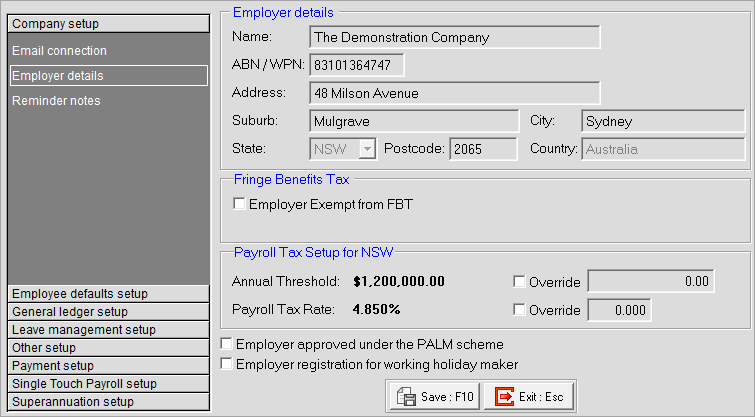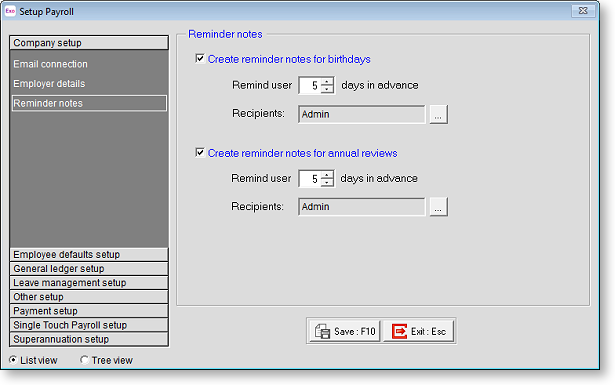Company Setup
The Company Setup section of the Setup Payroll window is where you specify details about your company as a whole. Company details are divided across three sub-sections:
Email connection
MYOB Exo Payroll has the ability to send payslips to employees electronically as PDF files. Providing that a significant number of your employees have access to their own computers and email accounts, and are not paid by cash, this may offer some long term financial savings in Payroll administration costs, as there is no expenditure or stocktaking involved for printers, payslip paper, ink cartridges, envelopes, postage, etc. Payslips are password-protected so that only the intended employee can read the file. The Email connection sub-section is where you specify the email details for your company.

Employees' email addresses are entered in the Other tab of the Employee Maintenance window.
SMTP Server To use the payslip emailing function you must have access to a Simple Mail Transfer Protocol (SMTP) Server. If your company has a Local Area Network (LAN), it is probable that it will have an internal SMTP server, as provided by your Network Administrator.
SMTP Port Specify the number of the port to send emails on. Consult your mail service provider or IT department for information on which port to use. This may depend on whether you want to use TLS or SSL encryption (see below).
User Name For an internal mail server (such as Exchange Server) this will be the User ID as configured for the user account in the Mail program. For ISP-hosted mail account this is the account name. This field is optional - if you leave this field blank, emails will be sent anonymously.
Password This is the password for your mail account. Tick Show Password to show the characters of the password; if this option is not ticked, the password will be masked with asterisks. You do not need to enter a password if the User Name field is blank.
Use SSL/TLS Tick this box to secure emails using TLS or SSL encryption, if the SMTP server supports them. SSL takes precedence over TLS; if both are available, SSL encryption will be used.
Sender Name Enter the name of the person responsible for sending the payslips (normally the pay clerk).
Sender's Email Address Enter the email address of the person responsible for sending the payslips (normally the pay clerk).
Message Enter a short note to the employee, which will appear in the body of the email.
Employer details
The address and contact details here identify the business entity for which this payroll company has been created, and will appear on the PAYG Payment Summary report.

Name Enter the company name, or optionally its trading name. It is common to have two payroll companies with separate login codes and access rights for each - one for salaried employees, and the other for waged employees. The company name always appears on the title bar of the main application window, indicating which payroll company you are currently logged into.
ABN/WPN The company's unique Australian Business Number or Withholding Payer Number, as provided by the Australian Tax Office.
Address This is usually the company's Post Office Box Number, or optionally a street name and number.
Suburb The locality at which correspondence will be received.
City The town/city/region at which correspondence will be received.
State Select from the list of Australian States.
Postcode The postal code pertaining to the company's address.
Country If the company is located outside of Australia, i.e. if the State is set to "OTH", enter the country in this field.
Employer Exempt from FBT Certain organisations such as charities and public hospitals are exempt from Fringe Benefits Tax (FBT). Tick this option if your organisation is exempt from FBT.
When an organisation is exempt from FBT, it is still possible for employees to perform duties that are FBT-exempt and some that are not. An option on the Non-Cash Benefits window in Standard Pays and Current Pays lets you mark individual benefits as exempt or non-exempt.
Fringe Benefits Exempt from FBT by Default This option is available if the company is exempt from FBT. Change this setting and click Save to update the Exempt from Fringe Benefits Tax (FBT) setting of all Fringe Benefit-type Non-Cash Benefits.
Payroll Tax Setup This section displays the payroll tax rate and threshold for the company's state. If necessary, you can override these values by ticking one or both of the Override boxes and entering new values.
Employer approved under the PALM scheme This checkbox marks the company as approved for the pacific australian labour mobility (PALM) scheme and sets tax to be withheld at 15% for the relevant employees.
Employer registration for working holiday maker This checkbox sets the payer as registered for working holiday maker. It contributes to the automatic allocation of tax treatment codes for employees using the Working Holiday Maker tax classification.
Reminder notes
Most reminder notes are entered manually for each employee. However, some reminder notes can be automatically generated. Two common events that occur at regular intervals are birthdays and annual reviews. Setting advance warnings of these events can result in more preparation time. For example, one evening to purchase a birthday gift, or one week to complete an annual review.

Create reminder notes for birthdays
This option tells the system to automatically generate a reminder note in the Show Reminders window when an employee is due to have a birthday.
Remind user x days in advance Generates the note earlier, for prior warning. For example, set this value to 1 to receive the reminder 1 day before the birthday.
Recipients C lick the 
Create reminder notes for annual reviews
This option tells the system to automatically generate a reminder note in the Show Reminders window when an employee is due to have a performance review.
Remind user x days in advance Generates the note earlier, for prior warning. For example, set this value to 1 to receive the reminder 1 day before the review.
Recipients Click the 
When the Current Pay is updated, the system will run an internal check to see if any employees are entitled to receive a note in the future. Appropriate notes will then appear in the Show Reminders window, either as an advance notification or as a notification on the day.
